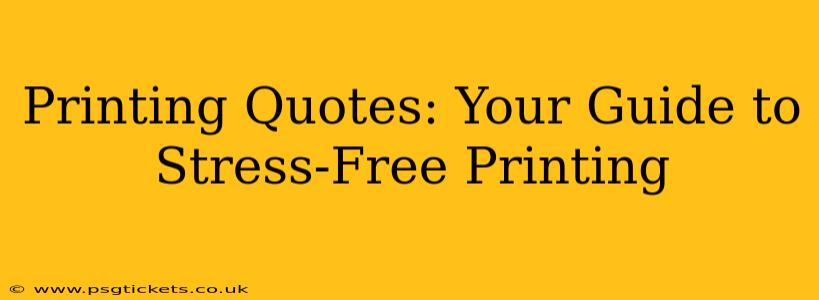Getting accurate and competitive printing quotes can feel like navigating a maze. This comprehensive guide will equip you with the knowledge and strategies to simplify the process, ensuring you receive the best possible price for your printing needs without the unnecessary stress. We'll cover everything from preparing your files to negotiating prices and choosing the right printer.
What Information Do I Need to Get an Accurate Printing Quote?
This is the foundational step. Incomplete information leads to inaccurate quotes and potential delays or cost overruns. To obtain a precise quote, you'll need:
- Project Details: Clearly specify the type of printing (e.g., business cards, brochures, posters, banners).
- Quantity: The exact number of prints required is crucial for accurate cost calculation. Be mindful of potential future needs and whether you want to order extra for contingencies.
- Dimensions & Paper Size: Provide exact measurements in inches or millimeters, including bleed if applicable (the extra area extending beyond the trim line). Specify the paper type and weight (e.g., 80lb gloss cover, 100lb uncoated).
- Color vs. Black & White: Specify if you require color printing or black and white. For color, indicate the color model (CMYK or Pantone).
- Finishing Options: Detail any finishing requirements, such as folding, binding (saddle stitch, perfect bind, wire-o), lamination, cutting, or embossing. These significantly impact the final cost.
- File Type: State the file format of your artwork (e.g., PDF, AI, PSD). High-resolution files are essential for quality printing.
- Delivery Method: Specify if you require delivery or will pick up the printed materials yourself.
- Rush Orders: If you need your project completed urgently, clearly communicate the deadline. Rush orders often incur additional charges.
How Can I Get the Best Printing Quotes?
Obtaining the best printing quotes involves a strategic approach. Here are some key tips:
- Get Multiple Quotes: Never settle for just one quote. Compare prices and services from at least three different printers.
- Understand the Pricing Structure: Be aware of per-unit costs, setup fees, and any additional charges for finishing options.
- Check for Hidden Costs: Ask for a detailed breakdown of the quote, ensuring no hidden costs are lurking. Clarify everything before committing.
- Negotiate: Don't be afraid to negotiate, particularly for large orders. Explain your budget and explore options for potential cost savings. Remember to be respectful and professional.
- Consider the Printer's Reputation: Research the printers you're considering. Look for reviews and testimonials to assess their reliability and quality of work.
- Ask About Turnaround Time: Inquire about their typical production time, especially if you have a deadline.
- Request Samples: If possible, request samples of their work to assess the quality of their printing and materials.
What Are the Different Types of Printing Methods?
Understanding the various printing methods helps you make informed decisions. The most common methods include:
- Offset Printing: Ideal for large print runs, offering high-quality results at a lower per-unit cost.
- Digital Printing: Best for smaller print runs and quicker turnaround times, offering versatility and customization options.
- Screen Printing: Excellent for t-shirts, posters, and other promotional materials, using stencils to apply ink.
What Should I Look for in a Good Printing Company?
Choosing the right printing partner is vital. Consider these factors:
- Reputation and Reviews: Check online reviews and testimonials to gauge their reliability and customer satisfaction.
- Communication: Ensure they're responsive and communicative, addressing your questions and concerns promptly.
- Quality of Work: Ask for samples or view their portfolio to assess the quality of their printing.
- Turnaround Time: Consider their production time to ensure it aligns with your deadline.
- Pricing and Transparency: Ensure they provide transparent pricing with no hidden costs.
How Can I Prepare My Files for Printing?
Proper file preparation is crucial for a smooth printing process and high-quality results. Key considerations include:
- High-Resolution Images: Use images with sufficient resolution (at least 300 DPI) to avoid pixelation.
- Correct Color Mode: Ensure your files are in the appropriate color mode (CMYK for most printing).
- Bleed and Safe Zones: Understand and implement bleed and safe zones to prevent important elements from being cut off during trimming.
- File Format: Provide your files in a suitable format (PDF is generally preferred).
By following these guidelines, you can streamline the process of obtaining printing quotes, ensuring you receive high-quality prints at competitive prices, ultimately leading to a stress-free printing experience. Remember, thorough preparation and careful selection of your printing partner are key to success.

